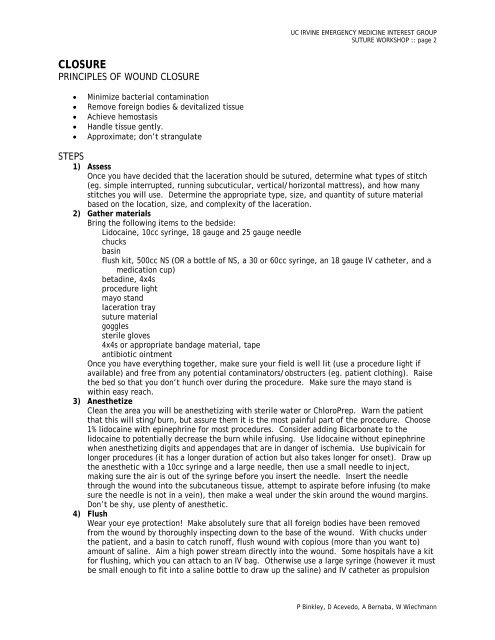Suture Workshop Handout - UCI Emergency Medicine Interest Group
Suture Workshop Handout - UCI Emergency Medicine Interest Group
Suture Workshop Handout - UCI Emergency Medicine Interest Group
You also want an ePaper? Increase the reach of your titles
YUMPU automatically turns print PDFs into web optimized ePapers that Google loves.
CLOSURE<br />
PRINCIPLES OF WOUND CLOSURE<br />
• Minimize bacterial contamination<br />
• Remove foreign bodies & devitalized tissue<br />
• Achieve hemostasis<br />
• Handle tissue gently.<br />
• Approximate; don’t strangulate<br />
UC IRVINE EMERGENCY MEDICINE INTEREST GROUP<br />
SUTURE WORKSHOP :: page 2<br />
STEPS<br />
1) Assess<br />
Once you have decided that the laceration should be sutured, determine what types of stitch<br />
(eg. simple interrupted, running subcuticular, vertical/horizontal mattress), and how many<br />
stitches you will use. Determine the appropriate type, size, and quantity of suture material<br />
based on the location, size, and complexity of the laceration.<br />
2) Gather materials<br />
Bring the following items to the bedside:<br />
Lidocaine, 10cc syringe, 18 gauge and 25 gauge needle<br />
chucks<br />
basin<br />
flush kit, 500cc NS (OR a bottle of NS, a 30 or 60cc syringe, an 18 gauge IV catheter, and a<br />
medication cup)<br />
betadine, 4x4s<br />
procedure light<br />
mayo stand<br />
laceration tray<br />
suture material<br />
goggles<br />
sterile gloves<br />
4x4s or appropriate bandage material, tape<br />
antibiotic ointment<br />
Once you have everything together, make sure your field is well lit (use a procedure light if<br />
available) and free from any potential contaminators/obstructers (eg. patient clothing). Raise<br />
the bed so that you don’t hunch over during the procedure. Make sure the mayo stand is<br />
within easy reach.<br />
3) Anesthetize<br />
Clean the area you will be anesthetizing with sterile water or ChloroPrep. Warn the patient<br />
that this will sting/burn, but assure them it is the most painful part of the procedure. Choose<br />
1% lidocaine with epinephrine for most procedures. Consider adding Bicarbonate to the<br />
lidocaine to potentially decrease the burn while infusing. Use lidocaine without epinephrine<br />
when anesthetizing digits and appendages that are in danger of ischemia. Use bupivicain for<br />
longer procedures (it has a longer duration of action but also takes longer for onset). Draw up<br />
the anesthetic with a 10cc syringe and a large needle, then use a small needle to inject,<br />
making sure the air is out of the syringe before you insert the needle. Insert the needle<br />
through the wound into the subcutaneous tissue, attempt to aspirate before infusing (to make<br />
sure the needle is not in a vein), then make a weal under the skin around the wound margins.<br />
Don’t be shy, use plenty of anesthetic.<br />
4) Flush<br />
Wear your eye protection! Make absolutely sure that all foreign bodies have been removed<br />
from the wound by thoroughly inspecting down to the base of the wound. With chucks under<br />
the patient, and a basin to catch runoff, flush wound with copious (more than you want to)<br />
amount of saline. Aim a high power stream directly into the wound. Some hospitals have a kit<br />
for flushing, which you can attach to an IV bag. Otherwise use a large syringe (however it must<br />
be small enough to fit into a saline bottle to draw up the saline) and IV catheter as propulsion<br />
P Binkley, D Acevedo, A Bernaba, W Wiechmann


